
The National Railroad Passenger Corporation, doing business as Amtrak, is the national passenger railroad company of the United States. It operates inter-city rail service in 46 of the 48 contiguous U.S. states and three Canadian provinces. Amtrak is a portmanteau of the words America and trak, the latter itself a sensational spelling of track.
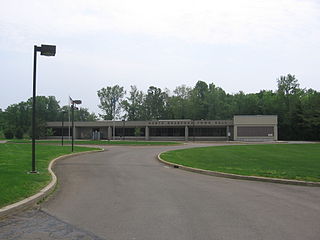
North Branford is a town in New Haven County, Connecticut, United States. The town is part of the South Central Connecticut Planning Region. The population was 13,544 at the 2020 census. The town is primarily known for agriculture and for other points of interest including Lake Gaillard and Northford Ice Pavilion. Wallingford, Durham, and North Haven border it to the north- East Haven to the west, Guilford to the east, and Branford to the south.

The Northeast Corridor (NEC) is an electrified railroad line in the Northeast megalopolis of the United States. Owned primarily by Amtrak, it runs from Boston in the north to Washington, D.C., in the south with major stops in Providence, New Haven, Stamford, New York City, Trenton, Philadelphia, Wilmington, and Baltimore. The NEC closely parallels Interstate 95 for most of its length, and, as of 2013, is the busiest passenger rail line in the United States both by ridership and by service frequency. The NEC carries more than 2,200 trains daily.

The New York, New Haven and Hartford Railroad, commonly known as The Consolidated, or simply as the New Haven, was a railroad that operated principally in the New England region of the United States from 1872 to December 31, 1968. Founded by the merger of the New York and New Haven and Hartford and New Haven railroads, the company had near-total dominance of railroad traffic in Southern New England for the first half of the 20th century.
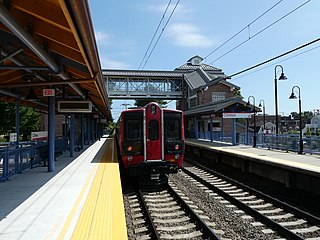
Shore Line East (SLE) is a commuter rail service which operates along the Northeast Corridor through southern Connecticut, United States. The rail service is a fully owned subsidiary of the Connecticut Department of Transportation (CTDOT) and is operated under the CT Rail brand. SLE provides service seven days a week along the Northeast Corridor between New London and New Haven; limited through service west of New Haven to Bridgeport and Stamford has been suspended since 2020. Cross-platform transfers to Metro-North Railroad New Haven Line trains are available at New Haven for service to southwestern Connecticut and New York City. Pre-COVID, around 2,200 riders used the service on weekdays.

The Providence and Worcester Railroad is a Class II railroad operating 612 miles (985 km) of tracks in Rhode Island, Massachusetts, and Connecticut, as well as New York via trackage rights. The company was founded in 1844 to build a railroad between Providence, Rhode Island, and Worcester, Massachusetts, and ran its first trains in 1847. A successful railroad, the P&W subsequently expanded with a branch to East Providence, Rhode Island, and for a time leased two small Massachusetts railroads. Originally a single track, its busy mainline was double-tracked after a fatal 1853 collision in Valley Falls, Rhode Island.

The Danbury Branch is a diesel branch of the Metro-North Railroad's New Haven Line in the U.S. state of Connecticut, running from downtown Norwalk north to Danbury. It opened in 1852 as the Danbury and Norwalk Railroad. Until the early 1970s, passenger service continued north from Danbury to Canaan, Connecticut, and Pittsfield, Massachusetts. Metro-North took over operation of the line from Conrail in 1983, and the modern-day branch is mostly single-tracked.

The Connecticut Southern Railroad is a 90-mile (140 km) long short-line railroad operating in Connecticut and Massachusetts. The company was formed in 1996 as a spinoff of Conrail by shortline holding company RailTex and subsequently acquired in 2000 by RailAmerica. Since 2012, it has been a subsidiary of Genesee & Wyoming. CSO is headquartered in Hartford, Connecticut, site of its Hartford Yard. The company also operates East Hartford Yard.

The New England Central Railroad is a regional railroad in the New England region of the United States. It began operations in 1995, as the successor of the Central Vermont Railway (CV). The company was originally a subsidiary of holding company RailTex before being purchased by RailAmerica in 2000. In 2012, the company was purchased by Genesee & Wyoming, its current owner.
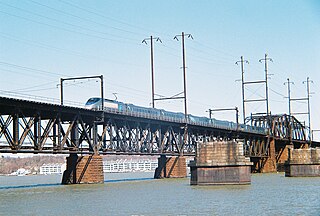
The Amtrak Susquehanna River Bridge is a Howe deck truss structure, opened in 1906, that carries two tracks of Amtrak's Northeast Corridor line across the Susquehanna River between Havre de Grace and Perryville, Maryland.

The Hartford and New Haven Railroad (H&NH), chartered in 1833, was the first railroad built in the state of Connecticut and an important direct predecessor of the New York, New Haven and Hartford Railroad. The company was formed to connect the cities of New Haven, Connecticut, and Springfield, Massachusetts. It built northwards from New Haven, opening its first segment in 1838, and reaching Hartford in December 1839. The company reached Springfield in 1844 under the auspices of the Hartford and Springfield Railroad, a subsidiary chartered in Massachusetts. Branches were later built to Suffield, New Britain, and Middletown and operated by the Hartford and New Haven. The H&NH merged with the New York and New Haven Railroad in 1872, forming the New York, New Haven and Hartford Railroad.

Clinton station is a regional rail station served by the CTrail Shore Line East service located near downtown Clinton, Connecticut. The station has two side platforms connected by a footbridge. Clinton is a commuter-only station; Amtrak's Acela Express and Northeast Regional services run through the station without stopping.
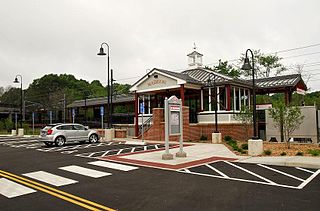
Madison station is a passenger rail station along CTrail's Shore Line East commuter rail line, which runs on the Northeast Corridor between New Haven and New London. Madison station consists of a mid-sized parking lot and one high-level side platform on the southbound side of the tracks.

The Branford Steam Railroad is a 7.2-mile (11.6 km) standard-gauge industrial railroad that serves the Tilcon Connecticut stone quarry in North Branford, Connecticut, in the United States. It was founded in 1903 by Louis A. Fisk, a businessman from Branford, Connecticut, to transport passengers to a trotting park for horses. Fisk also chartered the Damascus Railroad in 1905 to extend the route of the Branford Steam Railroad to North Branford to serve quarries. The Damascus Railroad's charter was amended in 1907 to allow a further extension to the site of a new quarry adjacent to Totoket Mountain. The Branford Steam Railroad took control of the Damascus Railroad in 1909, and has been the operator since.

Pan Am Southern, LLC is a freight railroad jointly owned by Norfolk Southern Railway (NS) and CSX Corporation. PAS is independently operated by the Berkshire and Eastern Railroad, a subsidiary of Genesee & Wyoming. PAS owns trackage known as the Patriot Corridor between Albany, New York, and the Boston, Massachusetts, area, utilizing rail lines formerly owned by the Fitchburg Railroad and later on the Boston and Maine Railroad. It was previously operated by PAR subsidiary Springfield Terminal Railway.
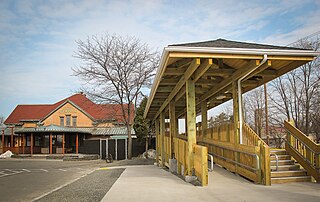
The Connecticut River Line is a railroad line owned by the Massachusetts Department of Transportation (MassDOT), running between Springfield and East Northfield, Massachusetts.

The Tomasso Group is a family-run conglomerate focused on the construction and real estate industries based in New Britain, Connecticut.
Angelo Tomasso Jr. was a businessman and philanthropist from New Britain, Connecticut.

Cedar Hill Yard is a classification yard located in New Haven, North Haven and Hamden, Connecticut, United States. It was built by the New York, New Haven and Hartford Railroad in the early 1890s in and around New Haven's Cedar Hill neighborhood, which gave the yard its name. Electrical catenary for electric locomotives was added to the yard in 1915. To handle increasing traffic as a result of World War I, the yard was greatly expanded between 1917 and 1920 with additional construction along both sides of the Quinnipiac River. The construction project added two humps where railroad cars were sorted into trains by gravity. The yard was further modernized in the 1920s, becoming one of the busiest railroad yards in the United States, and the most important yard in the entire New Haven Railroad system.

Railroads have played an important role in New England ever since the Granite Railway, America's first commercial railway, began operations in Massachusetts in 1826. As industrialization spread across the region, hundreds of railroads were built throughout the 19th century. Railroad mileage peaked around World War I, and from that point on mileage began to shrink. Despite this, railroads continue to be important for freight and passenger transportation in the region, with the New Haven Line holding the title of busiest railroad line in the entire United States.





















